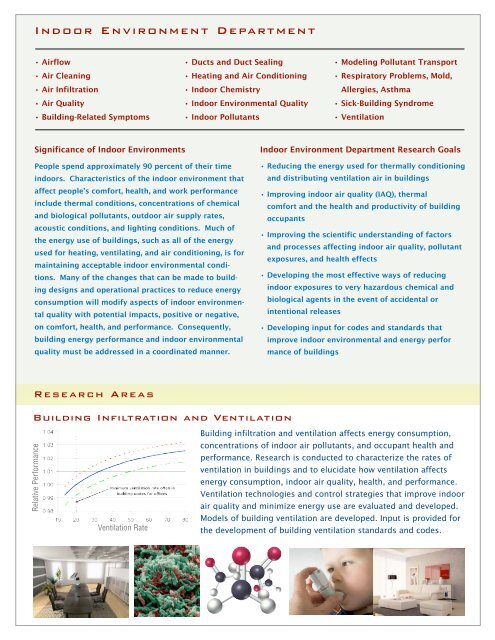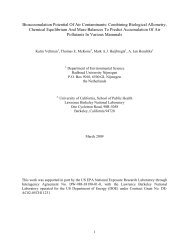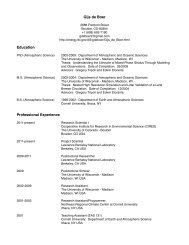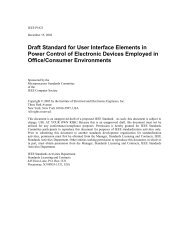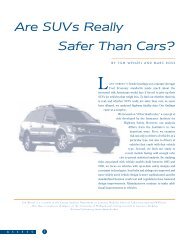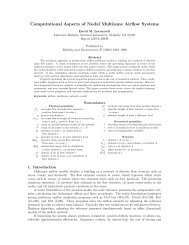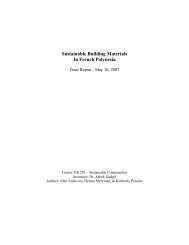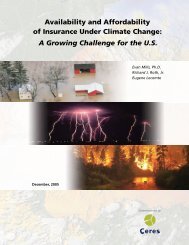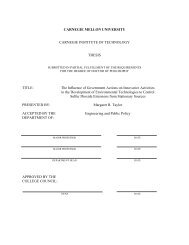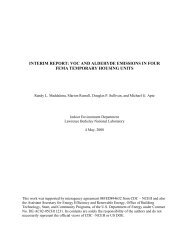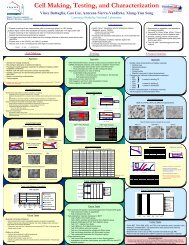Indoor Environment Department - Environmental Energy ...
Indoor Environment Department - Environmental Energy ...
Indoor Environment Department - Environmental Energy ...
You also want an ePaper? Increase the reach of your titles
YUMPU automatically turns print PDFs into web optimized ePapers that Google loves.
<strong>Indoor</strong> <strong>Environment</strong> <strong>Department</strong><br />
• Airflow<br />
• Air Cleaning<br />
• Air Infiltration<br />
• Air Quality<br />
• Building-Related Symptoms<br />
Significance of <strong>Indoor</strong> <strong>Environment</strong>s<br />
People spend approximately 90 percent of their time<br />
indoors. Characteristics of the indoor environment that<br />
affect people’s comfort, health, and work performance<br />
include thermal conditions, concentrations of chemical<br />
and biological pollutants, outdoor air supply rates,<br />
acoustic conditions, and lighting conditions. Much of<br />
the energy use of buildings, such as all of the energy<br />
used for heating, ventilating, and air conditioning, is for<br />
maintaining acceptable indoor environmental conditions.<br />
Many of the changes that can be made to building<br />
designs and operational practices to reduce energy<br />
consumption will modify aspects of indoor environmental<br />
quality with potential impacts, positive or negative,<br />
on comfort, health, and performance. Consequently,<br />
building energy performance and indoor environmental<br />
quality must be addressed in a coordinated manner.<br />
Research Areas<br />
• Ducts and Duct Sealing<br />
• Heating and Air Conditioning<br />
• <strong>Indoor</strong> Chemistry<br />
• <strong>Indoor</strong> <strong>Environment</strong>al Quality<br />
• <strong>Indoor</strong> Pollutants<br />
Building Infiltration and Ventilation<br />
Relative Performance<br />
Ventilation Rate<br />
• Modeling Pollutant Transport<br />
• Respiratory Problems, Mold,<br />
Allergies, Asthma<br />
• Sick-Building Syndrome<br />
• Ventilation<br />
<strong>Indoor</strong> <strong>Environment</strong> <strong>Department</strong> Research Goals<br />
• Reducing the energy used for thermally conditioning<br />
and distributing ventilation air in buildings<br />
• Improving indoor air quality (IAQ), thermal<br />
comfort and the health and productivity of building<br />
occupants<br />
• Improving the scientific understanding of factors<br />
and processes affecting indoor air quality, pollutant<br />
exposures, and health effects<br />
• Developing the most effective ways of reducing<br />
indoor exposures to very hazardous chemical and<br />
biological agents in the event of accidental or<br />
intentional releases<br />
• Developing input for codes and standards that<br />
improve indoor environmental and energy perfor<br />
mance of buildings<br />
Building infiltration and ventilation affects energy consumption,<br />
concentrations of indoor air pollutants, and occupant health and<br />
performance. Research is conducted to characterize the rates of<br />
ventilation in buildings and to elucidate how ventilation affects<br />
energy consumption, indoor air quality, health, and performance.<br />
Ventilation technologies and control strategies that improve indoor<br />
air quality and minimize energy use are evaluated and developed.<br />
Models of building ventilation are developed. Input is provided for<br />
the development of building ventilation standards and codes.


